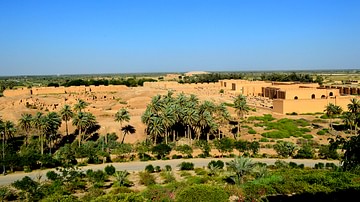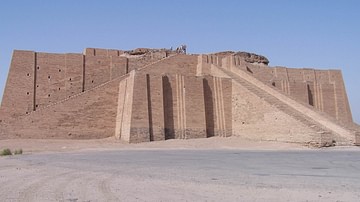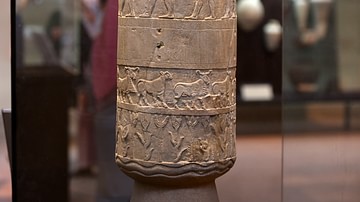Search
Search Results
![Throne Dais of Shalmaneser III [North-West Re-entrant, N. Face]](https://www.worldhistory.org/img/c/p/360x202/10528.jpg?v=1618801205)
Image
Throne Dais of Shalmaneser III [North-West Re-entrant, N. Face]
This scene is part of a long tributary one where Shalmaneser III (r. 858-824 BCE) receives tribute from Qalparunda (c. mid 9th Century BCE) of the Land of Unqi (a Luwian Syri-Hittite state, also known as Pattin). This is the rear part of...
![Throne Dais of Shalmaneser III [Front Panel]](https://www.worldhistory.org/img/c/p/360x202/10526.jpg?v=1733660592)
Image
Throne Dais of Shalmaneser III [Front Panel]
The front panel of this dais depicts Shalmaneser III (r. 858-824 BCE), (on the right) handshaking Marduk-zakir-shumi (r. 855 - 819 BCE) (left), king of Babylon. Both are surrounded by guards and stand below a fringed canopy supported by poles...
![Throne Dais of Shalmaneser III [South Face, East End]](https://www.worldhistory.org/img/c/p/360x202/10530.jpg?v=1599153303)
Image
Throne Dais of Shalmaneser III [South Face, East End]
This scene is part of a long tributary one where the Shalmaneser III (r. 858 - 824 BCE) receives Chaldean tribute from Musallim-Marduk, son of Ukani. The procession is headed by a bearded male figure (probably the prince). Before him...
![Throne Dais of Shalmaneser III [North Face, East End]](https://www.worldhistory.org/img/c/p/360x202/10523.jpg?v=1618801204)
Image
Throne Dais of Shalmaneser III [North Face, East End]
This scene is part of a long tributary one where the king receives tribute from Qalparunda of the Land of Unqi (a Luwian Syri-Hittite state, also known as Pattin). Here, the Assyrian king, Shalmaneser III (r. 858-824 BCE), stands below a...
![Throne Dais of Shalmaneser III [North-West Re-entrant, W. Face]](https://www.worldhistory.org/img/c/p/360x202/10527.jpg?v=1618584311)
Image
Throne Dais of Shalmaneser III [North-West Re-entrant, W. Face]
This scene is part of a long tributary one where Shalmaneser III (r. 858-824 BCE) receives tribute from Qalparunda of the Land of Unqi (a Luwian Syri-Hittite state, also known as Pattin). On the left, there are two figures, of whom the first...

Book Review
Lugalbanda: The Boy Who Got Caught Up in a War: An Epic Tale From Ancient Iraq (Aesop Prize (Awards))
Lugalbanda: The Boy Who Got Caught Up In A War is a fine re-telling of the ancient tale by Kathy Henderson with beautiful illustrations by Jane Ray. The fly leaf of the book states, "Older than the Bible, the Torah, and the Koran, the tale...

Article
Visiting the Ancient City of Babylon
We had a 4-day national holiday. Meaning what? No clinic and no hospital! I said to myself, “It's been a long time since I have visited Babylonia.” I drove my car for about 11 hours, continuously. Finally, I was there. I went to my uncle's...

Article
Ten Ancient Mesopotamia Facts You Need to Know
Mesopotamia is the ancient Greek name (meaning “the land between two rivers”, the Tigris and Euphrates) for the region corresponding to modern-day Iraq and parts of Iran, Syria, and Turkey. It is considered the “cradle of civilization” for...

Article
Battle of Karbala
The Battle of Karbala (10 October 680 CE) was a small-scaled military engagement, fought near the river Euphrates, in modern-day Iraq, which saw the massacre of heavily outnumbered Alid troops under the command of Husayn ibn Ali (l. 626-680...

Image
The Warka Vase
The Vase of Warka (also called Uruk Vase) is one of the earliest surviving examples of narrative art. It was excavated (in fragments) by a German excavation team in a temple complex dedicated to the goddess Inanna at the city of Uruk (in...